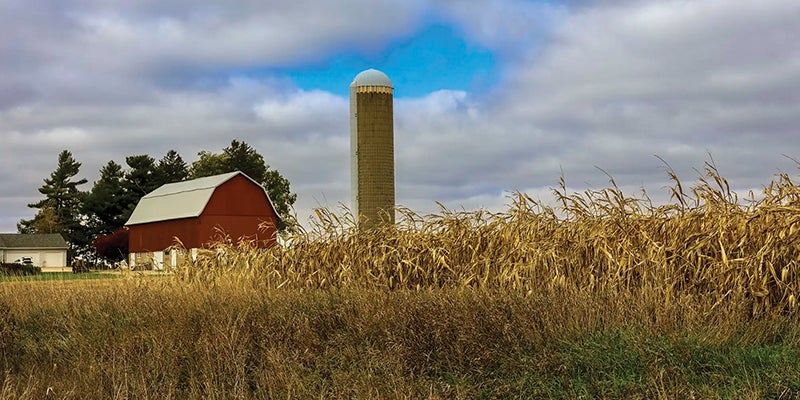Southeast Minnesota struggles for common ground on nitrate pollution as health worries rise
Published 9:02 am Tuesday, October 31, 2023

- Corn grows on a farm in rural Winona County. A majority of nitrate contamination in drinking water in southeast Minnesota comes from manure and commercial fertilizer applied to cropland. Kirsti Marohn | MPR News
|
Getting your Trinity Audio player ready...
|
By Kirsti Marohn
Corn once grew and livestock grazed on Paul Wotzka’s steeply sloped farm near Weaver, Minn., in rural Wabasha County, not far from the Mississippi River.
These days, Wotzka rotates annual crops with perennials such as garlic, grapes and hazelnut that keep the soil continuously covered. He uses only compost, no commercial fertilizer.
“We’re protecting the soil from the sun, we’re building organic matter and we are absorbing and retaining moisture,” said Wotzka, a hydrologist who previously worked for the Minnesota Pollution Control Agency.
Wotzka believes these changes have helped improve the groundwater, which he uses for drinking. Over 20 years, the nitrate level in his well has dropped by about 80 percent.
But improving water quality hasn’t been the trend across southeastern Minnesota. Nitrate has been a persistent problem in the region for decades, largely due to extensive agriculture and a karst landscape that makes the groundwater especially sensitive to pollution.
Some environmental groups say nitrate contamination has reached the point of a public health emergency, and they want the federal government to step in.
In a petition filed in April, they asked the U.S. Environmental Protection Agency to use its emergency powers under the federal Safe Drinking Water Act to intervene in what they call an “imminent and substantial endangerment to human health.”
“The EPA must act now to address this too-long ignored health crisis and ensure clean drinking water for Minnesotans,” it states.
Invisible threat
Nitrate — formed when nitrogen mixes with oxygen in water — is colorless, odorless and tasteless, and can easily go undetected if water isn’t tested, especially in old wells installed prior to current codes. Nitrogen is a common component of commercial fertilizer and animal manure used on crop land, and can leach into the groundwater.
Septic systems, wastewater treatment plants and fertilizer used on lawns and golf courses also can contribute to nitrate pollution.
Drinking water with high nitrate levels poses a health risk to humans, especially infants that can develop a sometimes-fatal condition called methemoglobinemia, or blue baby syndrome.
More recent research also has linked nitrate exposure to health effects for adults, including colorectal cancer, thyroid disease and neural tube defects.
The Safe Drinking Water Act usually applies to public water supplies that serve 25 or more people. But about 80,000 people in eight southeastern Minnesota counties rely on private wells for drinking water. They have few protections, said Wotzka, who co-founded a nonprofit called Minnesota Well Owners Organization, one of the petitioners.
“They don’t have to test,” he said. “If their test is bad, they don’t have to treat. Nobody is telling them to test, nobody’s helping them try to figure out the results.”
The Minnesota Department of Agriculture offers well testing in areas vulnerable to nitrate contamination. Test results from more than 30,000 wells tested showed about 9 percent had nitrate levels above the safe health limit.
In certain townships, as many as 40 percent of wells had nitrate over the limit, said Carly Griffith, water program director at the Minnesota Center for Environmental Advocacy, one of the groups that submitted the petition.
“The hydrogeology of the karst region makes it especially vulnerable to this type of contamination,” Griffith said. “And data from state agencies shows that the contamination has been persistent for decades.”
After the water crisis in Flint, Mich., the EPA issued new guidance about when the agency can use its emergency authority under the Safe Drinking Water Act. The language specifically mentions nitrate contamination in karst regions.
Since then, groups have filed similar petitions in other states, including Washington, Oregon and Wisconsin.
“It’s a way to get more aquifer-scale contamination, and to look at impacts to private well owners as well as those public water systems,” Griffith said.
It’s not clear yet whether the EPA will act on the Minnesota petition. Other groups that have signed on include the Clean Up the River Environment, Friends of the Mississippi River, the Izaak Walton League, Land Stewardship Project and Minnesota Trout Unlimited.
Jeff Broberg lives on a farm in Winona County’s Elba Township he bought in 1986. Back then, the nitrate level was about 8.6 parts per million, below the safe health limit for drinking water, Broberg said.
“Every time I tested it after that, it got higher,” he said.
After a decade, it was above the safe health limit of 10 milligrams per liter, or 10 parts per million, and Broberg couldn’t drink the water anymore. He blames the increase on surrounding crop farms and a nearby large hog operation.
As a geologist, Broberg knows the unique karst landscape here in southeastern Minnesota also plays a key role. Rolling hills, fractured bedrock and sinkholes allow water to flow quickly from the surface to the groundwater below.
It’s also the wettest part of the state, with the most annual precipitation. On Broberg’s property, water drains quickly into a rocky ravine.
“You can hear a sucking sound after a rain, and the water disappears,” he said. “Everything on the surface ends up in my groundwater.”
In karst landscapes, the distinction between groundwater and surface water is blurred. Water may flow from the ground as a spring, then flow into a disappearing stream.
Southeast Minnesota has many coldwater streams where trout and other fish species thrive. Because they’re closely connected to groundwater, they’re at risk of pollution.
In Minnesota, several state agencies regulate different aspects of water. The petitioners argue that’s led to an ineffective response to the nitrate issue.
“It is so easy for agencies to say, ‘Well, I’m just dealing with drinking water. I’m just dealing with surface water. I’m just dealing with water quantity,’” Wotzka said. “Somebody needs to put the big picture together.”
In a joint statement, the Minnesota Pollution Control Agency and state health and agriculture departments acknowledged southeastern Minnesota’s porous landscape is uniquely susceptible to groundwater contamination, exacerbated by climate change and more extreme rainfalls.
“State agencies, counties, cities and community members have been working to protect drinking water from nitrate contamination produced by faulty septic systems, agricultural runoffs, landfills and wastewater,” they stated.
The agencies mentioned Minnesota’s groundwater protection rule, which restricts the use of nitrogen fertilizer in the fall and on frozen soil in vulnerable areas, as well as a nitrogen fertilizer management plan that promotes best practices.
“While progress has been made, more work is required by state agencies, local governments, industry, farmers and homeowners to protect our waters, especially as we continue to adapt to our changing climate,” they stated.
Major source: Cropland farming
Officials from the state Pollution Control Agency say 89 percent of nitrate in southeast Minnesota water comes from commercial fertilizer and manure spread on cropland. That’s higher than the statewide average.
The petitioners say state agencies have relied mainly on voluntary approaches to get farmers to reduce nitrogen pollution, which they say haven’t worked.
They want the EPA to investigate the sources of nitrate, require those responsible to provide free well testing and, if needed, an alternative source of water.
“It can cost up to $30,000 to dig a deeper well for a private well owner,” Griffith said. “So in lower income rural communities, that can be an unachievable cost to meet.”
The petitioners are also calling for a moratorium on new or expanded large livestock farms until nitrate levels in contaminated wells reach safe levels.
The groups say CAFOs, or concentrated animal feeding operations where animals are raised in confinement, produce too much manure that’s applied to farm fields in the region.
Aaron and Amy Bishop live in Harmony Township in Fillmore County, about a mile from the Iowa border. Water from their well, which is more than 600 feet deep, is safe to drink. But many of their neighbors’ water isn’t, they said.
The Bishops are members of Responsible Ag in Karst Country, a grassroots organization that formed in 2018 in opposition to a proposed hog expansion.
“Obviously, agriculture is a huge contributor to the problem. But these farmers are also our neighbors, and they drink this water too,” Amy Bishop said. “So hopefully, if more information comes out, they’ll also recognize that this is the water they drink. And maybe there’s some way to start to reduce that.”
Some farmers say it’s unfair to blame the nitrate problem solely on them.
“As a farm guy, it’s hard to read the petition and not view it as an attack,” said Warren Formo, executive director of the Minnesota Agricultural Water Resource Center, formed in 2008 by the state’s major farm organizations. “It’s the tone and the tenor of it, and then singling agriculture out (for) what we see as some pretty drastic requirements.”
Many farmers in the region have substantially changed how they handle fertilizer and manure over the last two decades, Formo said. That includes following the state rule restricting the use of commercial fertilizer in sensitive areas in the fall, when it’s more likely to leach into the groundwater.
“We haven’t seen analysis, specifically in some of these areas, to see if it is making a difference,” Formo said.
One farmer voicing concern about the petition is state Rep. Steve Jacob, R-Altura, a former Winona County commissioner serving his first term in the Legislature.
Jacob said he cares about water quality and practices conservation measures on the land where he grows corn and beans, including no-till farming and cover crops. But he doesn’t support additional federal involvement.
“There’s two approaches: the carrot approach and the stick approach,” he said. “They’re saying [use] the stick approach. And not only is state and local government not enough, we need to have the federal government come in and bring the stick approach.”
Jacob said he’s counted more than 30 groups and dozens of programs already addressing water quality in southeast Minnesota.
“We know what best management practices are. And we need to implement those,” he said. “We should be streamlining things into less organizations, putting more of those dollars into actual programs on the ground, rather than all these expanded government programs.”
Even if the EPA doesn’t respond to the petition, environmental groups hope it’s raising awareness about the nitrate issue.
They’re hosting a series of public forums around the region, including one in Lanesboro on Nov. 16.
“There’s just so many people who aren’t aware that it’s an issue,” Amy Bishop said. “So just hopefully getting the conversation started, so that more people start to think about this, and maybe start to be vocal about it.”
They’re also urging well owners to get their water tested to find out the nitrate level.
The Minnesota Department of Health recommends having your well tested for nitrate every other year, through an accredited lab or your county environmental or public health service.





